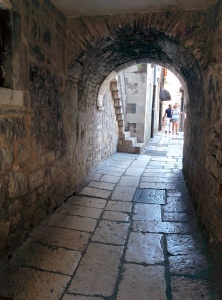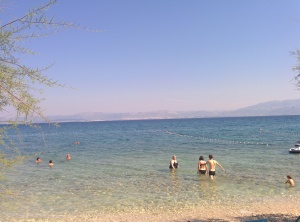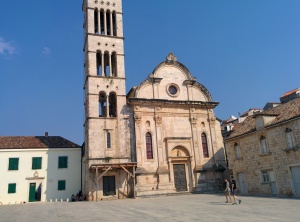We first went to Croatia quite by chance two years ago and loved it so much that we decided to return in August. It was the scenery that I fell in love with, the steep pine forest clad hills that fall into the sea, the clear blue, warm Adriatic waters and the abundance of bright flowers and olive groves. I’ve always liked going to different places too and although Croatia is part of Europe, it is far enough away from Britain, that its culture and language is completely different to ours, and so really interesting.
By chance I looked at the weather forecast before we left – 36 degrees in Split – ooof, that’s a bit hot I thought, making a mental note to make sure I had lots of shorts, high factor sun cream and hats for everyone. Little did I know that Croatia was having a heatwave summer, with temperatures the highest for 65 years. We flew into Split on a Thursday afternoon and made our way to our hotel in a taxi in the shimmering heat, the kind where just sitting still makes you sweat, familiar to me from my time in Kobe.
Split is the second biggest city in Croatia and it grew massively after WWII, a sprawl of ugly Soviet style tower blocks and factories, dwarfing the older stone buildings. It does however retain the Old Town that all the tourists come to see, and the forest clad mountains behind and the sparkly sea in front soften the utilitarian architecture that makes up much of the city.
Our hotel, the Filomena, came as a pleasant surprise. Secluded behind hedges in a residential district, it didn’t look like much from the outside and I was a little worried. I needn’t have done though, for our apartment was huge and immaculate, with two bedrooms, a large sitting room, a fully equipped kitchen and a bathroom, plus a balcony overlooking the garden. There was also a spa in the basement which we had free use of and a swimming pool which we were all in after 10 minutes of arriving. All for the bargain price of £25 per person per night.
We ate in the Old Town that evening, in a tiny backstreet taverna that we picked because it was off the beaten path and full of reserved tables. It was hot and sultry and we sat out in a tiny square, drank our cold beer thankfully and enjoyed the fresh seafood, whilst the ancient stone buildings towered above us, washing still flapping on the line and the odd cat appeared to beg for titbits. Walking back along the seafront the boys stopped for an ice-cream and there on the pavement was a little boy of about 3 in an orange stripey t-shirt dancing away to the music coming out of a nearby bar, oblivious to anything but the beat. Brilliant!

Split Old Town

Lost in music
Having one more day before we left for the island of Brac, we decided to look around the Old Town the next morning. Now I thought that the Diocletian’s Palace in the centre would be an actual palace but no what has happened is that the Roman Fortress that was there, with its myriad of buildings, was abandoned and over the centuries the townspeople built homes and shops within its walls, so the Old Town and the palace are one. It’s like many medieval European towns: tiny paved alleyways leading to hidden squares and stone buildings with pretty carvings, wrought iron balconies and faded shutters, that now mainly house shops and restaurants. It is thronged with people all hours of the day and night, shopping, chatting, eating and drinking and cars are banned. Game of Thrones is also filmed there, its narrow cobbled streets perfect for recreating Kings Landing and other towns in the series.

Split Old Town
The whole of the next day was spent travelling to Brac, our home for the next fortnight. Why Brac? When we came before, we spent a lot of time exploring the islands and loved them; for their rugged and unspoiled scenery and their marvellous beaches with crystal clear seas and resolved to stay on one if we ever came back.
The centre of Split grinds to a halt every Saturday in August as everyone queues for the ferries to different islands. As rental companies insist on letting apartments only from Saturday to Saturday in high season, guess what? Everyone is doing the same as everyone else, wanting to catch a ferry! It was late afternoon by the time we got to our rental, Fig Tree House, as we’d had trouble with the car hire company and were later catching the ferry than we’d intended. By that time we were all struggling to function in the heat – 39 that day- and the first thing we did was walk the short distance to the beach (30 m) and jump in the sea. Now the holiday could really begin!

Biastrica beach at the end of the lane with the mainland in the distance.
Home for the next fortnight was a cottage in the village of Sutivan, a small community on the north west side of the island. A fishing village around a small harbour, it still retains its close knit community despite the huge influx of tourists in the summer who come to enjoy island life and the beaches in particular. The village grew up around the small harbour, yellow stone buildings fronting cobbled lanes, enclosed gardens full of vines, bougainvillea and inviting shade, the church standing taller than all the rest with a little square in front of it. Shops, cafes, bakers, school; a typical small community, where everyone knows everyone else. A tiny road runs along the harbour and continues along the coast, no wall protecting you from the drop into the sea and every evening from 7pm it is shut to traffic to enable people to promenade along safely. Everyone comes out to eat, to drink, to buy icecream, to sit and talk to their neighbours and the kids play, whizzing up and down on bikes and skateboards.
I envied the local children their freedom and the joy of growing up in such a beautiful place. Every evening I saw the same groups of them playing, swimming in the sea and selling things they’d made to the tourists, all without a parent in sight; they were the same age as my boys and nobody, parents or other adults worried about their safety; it was really refreshing to see such a relaxed attitude. There are some stone benches along the harbour, less than a metre from the sea and the children used them as market stalls selling trinkets to passersby. Not a thought was given to the fact that one of them might fall into the sea, no, they were trusted to be sensible, a much better attitude than our over protective culture, where you are sometimes disapproved of if you give your children any freedom at all.

One of the old lanes in Sutivan

Sutivan harbour with the church tower in the distance

My favourite local fisherman, who went to check on his pots every night, seemingly oblivious to the tourist chatter around him. I can imagine his family doing this for generations.
Brac is a beautiful but incredibly rocky island. Stone here has been mined for centuries (there are plenty of Roman mines to visit) and graces some of the worlds most important buildings, such as the White House. As well as miles of dry stone walls bordering the fields and making terraces, there are round piles of stone everywhere you look, cleared by farmers so that they can cultivate olives and other crops. It is a hilly island, with the land rising steeply above the towns and villages on the coast, forming forest clad slopes of pines. Olives are one of the main crops here, with many farms pressing them into oil and there is an abundance of fruit trees too: fig, lemon, pomegranate, to name a few.
As well as the stunning Mediterranean scenery, the light has a different quality on Brac. The greens are greener and the blues are bluer and everything has a sharply defined edge. Best of all by early evening on a clear day, the landscape takes on a wonderful golden glow that we just don’t get here. I never tired of looking at it.
The absolute highlight of our holiday were the two boat trips we took. Being able to dive off a boat into the clear blue sea, when it’s pushing 40 degrees out is pure joy. It is also the best way to explore the islands and really appreciate the scenery; there are some places only accessible by boat. As we were staying in a fishing village there were a few boards advertising boat trips in the harbour, so we picked one we liked the look of, rang the number and arranged a day and a time.
The boys were excited as we piled into the small motorboat and made our way out of the harbour, laughing as we picked up speed and bounced over the waves, enjoying leaning back and catching the breeze. We were going to visit the island of Solta, not far from Brac, with plenty of stops for swimming along the way. The boat owner was a pleasant guy, who made us feel at home, let us swim for as long as we liked whenever we stopped, plied us with beer and coke and biscuits to feed the fish. How the boys laughed to see them jump to the surface of the water to eat the crumbs! After a couple of stops to swim in secluded bays, lunch was taken on a terrace overlooking the sea on Solta, little motorboats bobbing around in the harbour and a cluster of white houses on the hill opposite, surrounded by dark green pines. It was a heavenly day and one that will live long in my memory.

We had lunch right on the sea front on the island of Solta.

Joe enjoying our boat trip
The other boat trip was to the Pakleni Archipelago; a series of small islands off the coast of Hvar island, taking in the blue cave as well on the island of Bisevo, and a stop in Hvar Town on the way home. It was another extremely hot day as we boarded the boat along with a group of friendly Italians, and made our way out of the harbour.
Many of the Pakleni islands are uninhabited, a haven for wildlife with their thick pine forests and peaceful coves. Those houses that are there are mainly used in the summer; there are hardly any year round inhabitants. The whole of the Dalmatian coast is popular with sailors and we saw plenty of sailing boats and motor craft on our travels, people relaxing in the sun on top of their boats, swimming in the warm water and scuba diving; taking life at a slower pace.

Blue Cave on Bisevo island

Small cove on one of the islands
We stopped for a swim here:

Before heading to Palmizana, a large cove with a marina, restaurant and beach for our lunch and another swim:

Hvar Town was our final stop. This is the main square just off the waterfront:

One thing we love to do on holiday is follow our instinct and find out of the way places. We never worry about getting lost or not being able to cope with the situation and just enjoy it. Returning from Murvica, a beach on the other side of the island one evening, we decided to stop to eat on the way home as it was getting late. As we approached a village in the centre of the island, I saw a sign for a restaurant and told John to follow it.
What an amazing place! You went through a plain door in a stone wall and ended up in a courtyard with ancient stone buildings. Then one of the buildings itself had an inner courtyard with a pergola over it and vines growing in abundance. Another room had an enormous fireplace where they cooked all the meat and fish in traditional style and we sat watching them cook our lamb on a spit and potatoes under ash in a room with vaulted ceilings blackened by centuries of soot. There was an ancient olive press and a bread oven too. The young waiter appreciated my interest in the place, gave me a tour and told me all about it in excellent English. Everything, meat, vegetables, bread, cheese, olive oil etc was made by them, except the fish which was bought daily in nearby Bol.The place was 800 years old and you could just imagine people watching their dinner being cooked and drinking beer all that time ago too. I’ve never visited a place where history seemed so alive, quite astonishing.


Lazy days spent swimming at the local beach, playing cards and drinking beer at the bar were interspersed with trips further afield, exploring little towns and villages and cooling off in the sea. We’ve been seduced by the sunshine, the scenery, the swimming and the friendly locals in Croatia, so I’ve absolutely no doubt that we’ll be back!



















